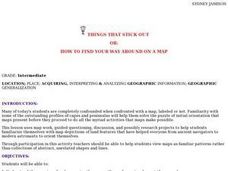Preswick House
Teaching Unit: Invisible Man
Invisible Man is a core text in high school literature classes and one of the most cited works on the AP Literature and Composition exam. Instructors new to using Ralph Ellison's novel and those who have long included it as part of...
Texas Education Agency (TEA)
Byzantine Architecture
View Byzantine architecture from the comfort of your classroom. A PowerPoint presentation introduces important vocabulary terms and examples of Byzantine architecture in the ninth instructional activity of the 11-part series. A Jeopardy...
Prestwick House
Ten Days to A+ Grammar: Verbs
What are you doing today? What have you done this week? What will you be doing next month? Focus on verb usage with a series of fill-in-the-black exercises on basic tenses, inappropriate shifts in tense, and active and passive voice.
Prestwick House
The Grapes of Wrath
At over 450 pages, John Steinbeck's Pulitzer Prize winning novel The Grapes of Wrath can be a challenging choice for full-class, book circle, or independent reading. The activities in a 10-page sample The Grapes of Wrath...
Prestwick House
Wuthering Heights
How many ways can you break down a classic novel? Based on the acclaimed Romantic-period novel by Emily Bronte, the Wuthering Heights activity pack includes a pre-reading exercise. Next, learners create a resume for one of the...
Prestwick House
Fahrenheit 451—Activity Pack
The burning questions is at what point do readers of Fahrenheit 451 recognize the many literary devices Ray Bradbury employs in his dystopian classic that warns of a society that uses media to indoctrinate the public and denigrates...
EngageNY
Mid-Unit Assessment: Comparing and Contrasting Two Texts: Simulated Research
Shoo fly. Scholars read DDT Spray Scares Mosquitoes Away, Study Finds and You Think You Have It Tough? to complete a mid-unit assessment. The learners compare and contrast author presentation and conduct a credibility check on each...
EngageNY
Research Tasks: New Words, Relevant Information, Revision
Word builders. Scholars participate in a mini lesson about affixes. They then complete a research vocabulary organizer and share their definitions of the words with the class. They gather more evidence for their research from the...
Alabama Learning Exchange
Look at me!
Third graders write an autobiography and use pictures of themselves from past and present to illustrate it. They take pictures with a digital camera, scan pictures, and add them to a document.
Curated OER
Centipede or Millipede?
Students discuss millipedes and centipedes in terms of their classification as arthropod. Using a diagram, students categorize and compare and contrast the characteristics of millipedes and centipedes based on their discussion of...
Alabama Learning Exchange
The Causes of Pollution
Learners identify types of pollution. In this environmental lesson, students view a video and discuss the types of pollution. Learners create a poster to suggest ways to prevent pollution.
Curated OER
American Literature Unit Two
Students prepare for and respond to literature selections. This package includes nineteen lessons from the American Literature, A New Nation: 1750-1850 series, each covering a different reading selection. Pre-reading and response...
Curated OER
American Literature Unit Four
Students prepare for and respond to literature selections. This package includes twelve lessons from the American Literature, Regionalism and Realism: 1865-1910 series, each covering a different reading selection. Pre-reading and...
Curated OER
Life's Lessons: Survival of the Fittest
Students analyze Jack London's use of anthropomorphism to identify the importance of adaptability in life. In this literature lesson, students use the novel The Call of the Wild to identify key elements in survival. Students...
Curated OER
Defining the Difference Between Prokaryotic and Eukaryotic Cells
Learners examine microscopic life by conducting a scientific investigation. For this cell analysis lesson, students define the prokaryotic and eukaryotic cells and discuss their word origins. Learners view each type of cell on slides...
Curated OER
Decimal Numbers - Tenths
In this tenths worksheet, students write the decimal numbers on the number lines represented by tenths. Students write 70 decimal numbers.
Curated OER
Things That Stick Out Or: How To Find Your Way Around on a Map
Students explain the meaning of and recognize the map outlines of a peninsula, an isthmus, and a cape.
Curated OER
What is culture?
What is culture? Define culture, artifacts, subcultures, and multiculturalism with your class. This presentation provides a definition, example, and image of each facet of culture.
Prestwick House
Touching Spirit Bear: Individual Learning Packet
Whether using Touching Spirit Bear in the classroom, as an outside reading assignment, or in a homeschool situation, your readers will benefit from this eight-page packet of essay and discussion questions, vocabulary lists, and reading...
Curated OER
Vocabulary of Ancient Rome Grades 9-12)
Students define ancient Roman vocabulary using the dictionary writing sentences.
Curated OER
Trouble in the Fields: Mexican Migrant Workers
Students become curators and museum reviewers for an online gallery using a selected group of primary sources on Mexican migrant workers. They share and reflect on their own and each other's ideas though participation in an on-line...
Alabama Learning Exchange
Echolocation Stations: Exploring Sound
Fourth graders explore the concept of echolocation during a unit on whales. They listen to the book and watch the Reading Rainbow video for "Humphrey: The Wayward Whale," explore various websites, and conduct experiments to demonstrate...
Curated OER
Creature Feature
Students make detailed observations and identify an unknown using descriptions. For this observation lesson students are given a creature and must be able to identify it by species and genus.
Curated OER
After the Garbage Can: Where Does Our Trash Go?
Students explore how waste disposal has changed over time and what the current issues are. In this disposal lesson students collect data and create graphs.
Other popular searches
- Latin Root Words
- Greek and Latin Roots
- Latin Roots
- Greek and Latin Root Words
- Greek Latin Root Words
- Latin Roots and Affixes
- Latin Word Roots
- Science Latin Root Words
- Greek Latin Roots
- Vocabulary Greek Latin Roots
- Latin Root Words Medical
- Latin Root Word Study
























